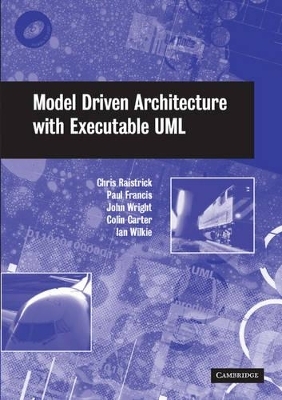
Model Driven Architecture with Executable UML
Seiten
2004
Cambridge University Press
978-0-521-53771-1 (ISBN)
Cambridge University Press
978-0-521-53771-1 (ISBN)
- Titel ist leider vergriffen;
keine Neuauflage - Artikel merken
This book describes how to automatically generate executable code directly from UML model specifications using OMG's Model Driven Architecture (MDA) and Executable UML (xUML) technologies. An excellent reference for anyone embarking on what is surely the future of software development for medium and large scale projects.
This book offers a unique insight into a revolution in software development that allows model specifications to be fully and efficiently translated into code. Using the most widely adopted, industry standard, software modelling language, UML, the reader will learn how to build robust specifications based on OMG's Model Driven Architecture (MDA). From there, the authors describe the steps needed to translate the Executable UML (xUML) models to any platform-specific implementation. The benefits of this approach go well beyond simply reducing or eliminating the coding stage - it also ensures platform independence, avoids obsolescence (programming languages may change, the model doesn't) and allows full verification of the models by executing them in a test and debug xUML environment. This is an excellent reference for anyone embarking on what is surely the future of software development for medium and large scale projects.
This book offers a unique insight into a revolution in software development that allows model specifications to be fully and efficiently translated into code. Using the most widely adopted, industry standard, software modelling language, UML, the reader will learn how to build robust specifications based on OMG's Model Driven Architecture (MDA). From there, the authors describe the steps needed to translate the Executable UML (xUML) models to any platform-specific implementation. The benefits of this approach go well beyond simply reducing or eliminating the coding stage - it also ensures platform independence, avoids obsolescence (programming languages may change, the model doesn't) and allows full verification of the models by executing them in a test and debug xUML environment. This is an excellent reference for anyone embarking on what is surely the future of software development for medium and large scale projects.
Kennedy Carter Limited are a leading provider of executable UML solutions and consulting services for the modelling, design and implementation of complex software systems using the OMG's (Object Management Group™) Model Driven Architecture™ (MDA™).
1. Introduction; 2. The process; 3. xUML in a typical project; 4. Use case analysis; 5. Domain partitioning; 6. Class modelling in a domain; 7. Behaviour modelling; 8. Operation modelling; 9. Dynamic modelling; 10. Action specification; 11. Modelling patterns; 12. Integrating domains; 13. System generation; 14. Case study.
| Erscheint lt. Verlag | 18.3.2004 |
|---|---|
| Zusatzinfo | 285 Line drawings, unspecified |
| Verlagsort | Cambridge |
| Sprache | englisch |
| Maße | 174 x 246 mm |
| Gewicht | 850 g |
| Themenwelt | Informatik ► Software Entwicklung ► Objektorientierung |
| Informatik ► Software Entwicklung ► UML | |
| ISBN-10 | 0-521-53771-1 / 0521537711 |
| ISBN-13 | 978-0-521-53771-1 / 9780521537711 |
| Zustand | Neuware |
| Haben Sie eine Frage zum Produkt? |